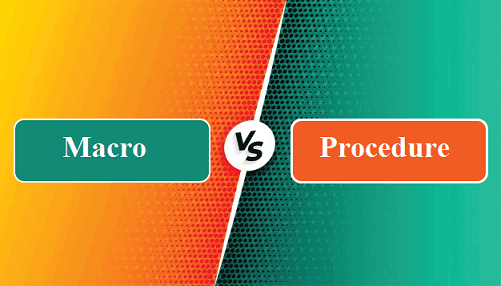Difference between Macro and ProcedureA microprocessor is a computer system processor that accomplishes the functions of a CPU on a single integrated circuit. It manages the output devices, processes instructions stored in its memory, and shows the results. These processors are made up of both combinational and sequential digital circuitry. Furthermore, Assembly language is a programming language that aids in the programming of microprocessors. Both Macro and Procedure are two ideas that are utilized in microprocessor programming. The primary distinction between these processes is that the Macro is utilized for a small number of commands. In contrast, the Procedure is utilized for a large number of instructions. In this article, you will learn about the difference between Macro and Procedure. But before discussing the differences, you must know about Macro and Procedure. What is Macro?Macro is a sequence of instructions that may be utilized anywhere in the software by utilizing its name. It is primarily used for modular programming. As a result, the same set of instructions may be utilized several times with the help of a macro. The macro's identifier is substituted with the actual defined instructions during compilation. Therefore no calling and returning occur. Syntax: Explanation: The macro_name is used to identify the macro, while the number_of_params is utilized to represent the number of parameters. In addition, the macro can be invoked using the macro name and the appropriate parameters. As a result, if the same set of directives must be executed numerous times, the programmer may write those directives in a macro and utilize it in his program. What is the Procedure?Procedures are similar to macros, but these are utilized for large sets of instructions, whereas macros are beneficial for tiny sets of instructions. It includes sets of instructions that accomplish a specified goal. It has three major components: the procedure name, which identifies the process. The procedure body contains a sequence of instructions, and the RET statement, which signifies the return statement. Procedures use the call-return approach to achieve complete modularity. Syntax: To call a procedure function, you can use this: Finally, the control transfers to the calling procedure via the RET instruction after the procedure has been completed. Key Differences between Macro and Procedure
Here, you will learn about the key differences between Macro and Procedure. Some of the main differences between the Macro and Procedure are as follows:
Head-to-head comparison between Macro and ProcedureHere, you will learn the head-to-head comparisons between Macro and Procedure. The main differences between Macro and Procedure are as follows:
ConclusionIn summary, assembly language is a popular programming language that is utilized for microprocessor programming, and Macro and Procedure are two Assembly concepts. A macro is utilized for a limited number of instructions, usually less than ten. In contrast, a procedure is utilized for a large number of instructions, usually more than ten.
Next TopicDifference between
|
 For Videos Join Our Youtube Channel: Join Now
For Videos Join Our Youtube Channel: Join Now
Feedback
- Send your Feedback to [email protected]
Help Others, Please Share










